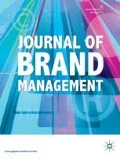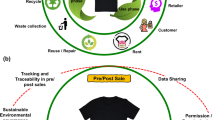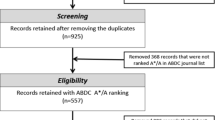Abstract
Cities invest large sums of money in ‘flagship projects’, with the aim of not only developing the city as such, but also changing the perceptions of the city brand towards a desired image. The city of Hamburg, Germany, is currently investing €575 million in order to build a new symphony hall (Elbphilharmonie), €400 million to develop the ‘International Architectural Fair’ and it is also considering candidature again for the ‘Olympic Games’ in 2024/2028. As assessing the image effects of such projects is rather difficult, this article introduces an improved version of the Brand Concept Map approach, which was originally developed for product brands. An experimental design was used to first measure the Hamburg brand as such and then the changes in the brand perceptions after priming the participants (N=209) for one of the three different flagship projects. The findings reveal several important structural differences for the brand image dimensions of the city contingent upon the type of flagship project. Hence, this study shows (i) that different flagship projects have different image effects for the city brand and (ii) provides a novel method for measuring perceived place brand image effects of both ongoing and future flagship projects.







Similar content being viewed by others
References
Ashworth, G.J. and Kavaratzis, M. (2009) Beyond the logo: Brand management for cities. Journal of Brand Management 16 (8): 520–531.
Ashworth, G.J. and Voogd, H. (1990) Selling the City: Marketing Approaches in Public Sector Urban Planning. London Belhaven.
Becker-Olsen, K.L. and Hill, R.P. (2006) The impact of sponsor fit on brand equity – The case of non-profit service providers. Journal of Service Research 9 (1): 73–83.
Braun, E. (2012) Putting city branding into practice. Journal of Brand Management 19 (4): 257–267.
Butler, T. (2007) Re-urbanizing London Docklands: Gentrification, suburbanization or new urbanism? International Journal of Urban and Regional Research 31 (4): 759–781.
Docherty, I. and McKiernan, P. (2008) Scenario planning for the Edinburgh city region. Environment and Planning C: Government and Policy 26 (5): 982–997.
Dolch, N.A. (1980) Attitude measurement by semantic differential on a bipolar scale. The Journal of Psychology 105 (2): 151–154.
Evans, G. (2003) Hard-branding the cultural city – From Prado to Prada. International Journal of Urban and Regional Research 27 (2): 417–440.
Federal Statistical Office of Hamburg and Schleswig-Holstein (2012) Statistisches Jahrbuch Hamburg 2011/2012. Hamburg, Germany: Federal Statistical Office of Hamburg and Schleswig-Holstein.
Florida, R. (2004) The Rise of The Creative Class. New York Basic Books.
Gertner, D. (2011) A (tentative) meta-analysis of the ‘place marketing’ and ‘place branding’ literature. Journal of Brand Management 19 (2): 112–131.
Gospodini, A. (2009) Post-industrial trajectories of mediterranean European cities: The case of post-Olympic Athens. Urban Studies 46 (5/6): 1157–1186.
Grunert, K.G. and Grunert, S.C. (1995) Measuring subjective meaning structures by the laddering method: Theoretical considerations and methodological problems. International Journal of Research in Marketing 12 (3): 209–226.
Hamburg Marketing GmbH (2006) Feuer und Flamme für Olympia in Hamburg – Konzeptionelle Eckpunkte für eine Bewerbung Hamburgs um die Olympischen Spiele. Hamburg, Germany: City of Hamburg.
Hamburg Marketing GmbH (2010) Elbphilharmonie Hamburg, http://www.elbphilharmonie-bau.de, accessed 10 December 2010.
Hamburg Marketing GmbH (2012) Facts & figures on Hamburg and the metropolitan area, http://www.marketing.hamburg.de/Daten-Fakten.102.0.html?L=1, accessed 11 October 2012.
Hiller, H.H. (1998) Assessing the impact of mega-events: A linkage model. Current Issues in Tourism 1 (1): 47–57.
Huber, F., Beckmann, S.C. and Herrmann, A. (2004) Means-end analysis: Does the affective state influence information processing style? Psychology & Marketing 21 (9): 715–737.
IBA Hamburg GmbH (2010) IBA_Hamburg, http://www.iba-hamburg.org/en/00_start/start.php, accessed 10 December 2010.
Iversen, N.M. and Hem, L.E. (2008) Provenance associations as core values of place umbrella brands. European Journal of Marketing 42 (5/6): 603–626.
Jensen, O.B. (2007) Culture stories: Understanding cultural urban branding. Planning Theory 6 (3): 211–236.
John, D.R., Loken, B., Kim, K. and Monga, A.B. (2006) Brand concept maps: A methodology for identifying brand association networks. Journal of Marketing Research 43 (4): 549–563.
Kahn, H. (1965) On Escalation, Metaphor and Scenarios. New York: Praeger.
Keller, K.L. (1993) Conceptualizing, measuring, and managing customer-based brand equity. Journal of Marketing 57 (1): 1–22.
Kent, T. (2009) Concepts of flagships. In: T. Kent and R. Brown (eds.) Flagship Marketing – Concepts and Places. New York Routledge, pp. 8–19.
Kotler, P. and Gertner, D. (2002) Country as brand, product, and beyond: A place marketing and brand management perspective. Journal of Brand Management 9 (4/5): 249–261.
Kotler, P., Haider, D.H. and Rein, I. (1993) Marketing Places: Attracting Investment, Industry, and Tourism to Cities, States, and Nations. New York: The Free Press.
Lynch, K.A. (1960) The Image of the City. Cambridge, US: MIT Press.
Meyers-Levy, J. (1989) Priming effects on product judgments: A hemispheric interpretation. Journal of Consumer Research 16 (1): 76–86.
Neuendorf, K.A. (2002) The Content Analysis Guidebook. Thousand Oaks, CA: Sage Publications.
Paddison, R. (1993) City marketing, image reconstruction and urban regeneration. Urban Studies 30 (2): 339–350.
Peterson, R.A. (2001) On the use of college students in social science research: Insights from a second-order meta-analysis. Journal of Consumer Research 28 (3): 450–461.
Petty, R.E. and Cacioppo, J.T. (1986) The elaboration likelihood model of persuasion. In: L. Berkowitz (ed.) Advances in Experimental Social Psychology. New York: Academic Press, pp. 123–205.
Richards, G. and Wilson, J. (2004) The impact of cultural events on city image: Rotterdam, cultural capital of Europe 2001. Urban Studies 41 (10): 1931–1951.
Roediger, H.L. and McDermott, K.B. (1993) Implicit memory in normal human respondents. In: F. Boller and J. Grafman (eds.) Handbook of Neuropsychology. Amsterdam, the Netherlands: Elsevier, pp. 63–131.
Schnittka, O., Sattler, H. and Zenker, S. (2012) Advanced brand concept maps: A new approach for evaluating the favorability of brand association networks. International Journal of Research in Marketing 29 (3): 265–274.
Simmons, C.J. and Becker-Olsen, K.L. (2006) Achieving marketing objectives through social sponsorships. Journal of Marketing 70 (3): 154–169.
Smith, A. (2005) Reimaging the city: The value of sport initiatives. Annals of Tourism Research 32 (1): 217–236.
Smith, A. (2006) Assessing the contribution of flagship projects to city image change: A quasi-experimental technique. International Journal of Tourism Research 8 (6): 391–404.
Smyth, H. (1994) Marketing the City: The Role of Flagship Projects in Urban Regeneration. London: Spon Press.
Stiftung Elbphilharmonie (2010) Die Elbphilharmonie, http://www.stiftung-elbphilharmonie.de/elbphilharmonie.html, accessed 10 December 2010.
Uggla, H. (2006) The corporate brand association base – A conceptual model for the creation of inclusive brand architecture. European Journal of Marketing 40 (7/8): 785–802.
Wansink, B. (2003) Using laddering to understand and leverage a brand’s equity. Qualitative Market Research: An International Journal 6 (2): 111–118.
Ward, S.V. (1998) Selling Places: The Marketing and Promotion of Towns and Cities 1850–2000. London and New York: Spon Press.
Zenker, S. (2009) Who’s your target? The creative class as a target group for place branding. Journal of Place Management and Development 2 (1): 23–32.
Zenker, S. (2011) How to catch a city? The concept and measurement of place brands. Journal of Place Management and Development 4 (1): 40–52.
Author information
Authors and Affiliations
Corresponding author
Additional information
1PhD, is an Assistant Professor at the Erasmus School of Economics, Erasmus University Rotterdam, funded by the German Research Council (DFG). His current research interests are mainly the measurement of place brands and place brand perceptions with the special target group of residents. His work was presented at various international conferences, book chapters, peer-reviewed journals, for example, the International Journal of Research in Marketing, Cities, or the Journal of Business Ethics.
Rights and permissions
About this article
Cite this article
Zenker, S., Beckmann, S. Measuring brand image effects of flagship projects for place brands: The case of Hamburg. J Brand Manag 20, 642–655 (2013). https://doi.org/10.1057/bm.2013.6
Received:
Revised:
Published:
Issue Date:
DOI: https://doi.org/10.1057/bm.2013.6




